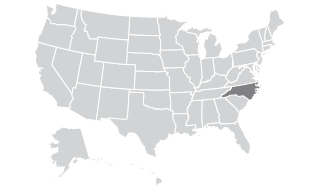Republican challenger Mitt Romney has fought Democratic President Barack Obama to what remains essentially a tied contest in the Tar Heel state, 49% Romney to 48% Obama, in a YouGov poll of 810 likely voters statewide (recontacted from an initial September poll).
| In North Carolina (Oct 4-11): |
|---|
North Carolina is a strongly partisan state in its vote, as 94% of Democrats are sticking with Obama and 90% of Republicans are voting for Romney. |
Romney enjoys a large lead among likely voters who are Independents, 56% for Romney and 39% for Obama. |
Women favor Obama by 54%-43%, while men favor the challenger over the incumbent, 55% Romney-42% Obama. |
Obama enjoys a solid 59%-40% advantage in the Raleigh-Durham-Triangle area, and also leads 51%-46% around Charlotte. Romney leads narrowly in the Piedmont and central North Carolina (50%-47%) and Romney runs even stronger in western North Carolina (54%-43%). |
The oldest likely voters age 65+ favor Romney by 2-to-1 over Obama (66% Romney-33% Obama), and Baby Boomers strongly prefer Romney as well (56% Romney-41% Obama). Obama wins over 60% of the vote from voters under age 45, making North Carolina the site of one of the biggest generation gaps in the country. |
Among likely voters who are Independents, Romney held a large lead over Obama in September, but the President is beginning to close the gap. Romney leads by a 17-point margin among Independent likely voters now (56%-39%), and he led by a 26-point margin in September (57%-31%). |
| Net Change in Voter Intention (Likely Voters) |
|---|
| Total | Independents | |||
|---|---|---|---|---|
Sept 7-14 | Oct 4-11 | Sept 7-14 | Oct 4-11 | |
Barack Obama | 46% | 48% | 31% | 39% |
Mitt Romney | 48% | 49% | 57% | 56% |
Republican Pat McCrory holds a 50%-34% lead over Democrat Walter Dalton in the race for Governor, largely unchanged from a 49%-33% McCrory lead in September among likely voters.
Voters in North Carolina are divided in their choice for the U.S. House, as the Republican House candidates are nominally ahead of the Democrats, with 42% intending to vote for the Republican candidate for the House in their district and 39% for the Democrat. The poll was conducted online October 4-11, 2012.
Sampling method: Respondents were initially selected on September 7-14 from YouGov’s panel using sample matching. A random sample (stratified by age, gender, race, education, and region) was selected from the 2005–2007 American Community Study. Voter registration, turnout, religion, news interest, minor party identification, and non-placement on an ideology scale, were imputed from the 2008 Current Population Survey Registration and Voting supplement and the Pew Religion in American Life Survey. Matching respondents were selected from the YouGov panel, an opt-in Internet panel.
Respondents were recontacted on October 4-11 for the second wave of the YouGov poll. The percentage of likely voters who were successfully recontacted was 77.2%.
Weighting: The sample was weighted using propensity scores based on age, gender, race, education, news interest, voter registration, and non-placement on an ideology scale.
Number of respondents: 810 likely voters. Margin of error ±3.9% (adjusted for weighting).
Click here for September 7-14 results (registered voters).
Click here for October 4-11 results (likely voters).










